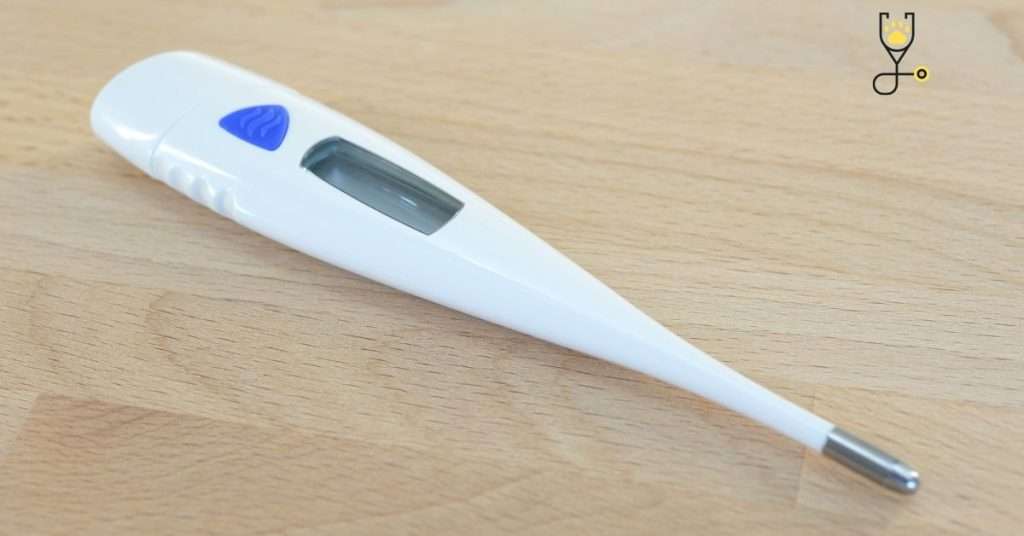A fever in a dog can be a sign of many different things, from a simple infection to something more serious. That’s why it’s important to know how to check your dog’s temperature and take action if it is high. In this blog post, we’ll discuss the best ways to measure your dog’s fever and what you should do if it rises above normal levels. We’ll also go over some tips for keeping your dog healthy and comfortable during a fever. Read on to learn more!
Read More: How to overcome the anxiety and depression of your dog?
What is the normal body temperature of a dog?
The normal body temperature for dogs is between 100.5-102.5 degrees Fahrenheit. This can vary slightly depending on the method used to take the temperature (rectal, ear, armpit, or oral).
If you are unsure of your dog’s normal temperature, it is best to consult with your veterinarian.
Different Ways To Check Dog’s Body Temperature
There are a few different ways that you can check your dog’s temperature. The most accurate way is to take their temperature rectally, but this may not be possible or practical for all owners. If you cannot take your dog’s rectal temperature, you can try taking their temperature from the ear or by using a special thermometer designed for dogs.
Here are instructions for each method:
1. Rectal Temperature
The most accurate way to measure your dog’s temperature is rectally, but this may not be possible or practical for all owners. To take your dog’s rectal temperature, you will need to use a digital thermometer designed for animals. Lubricate the tip of the thermometer with petroleum jelly and insert it into your dog’s rectum about one inch. Hold the thermometer in place for 60 seconds, then remove and check the reading.

The normal rectal temperature for dogs is between 100.5-102.5 degrees Fahrenheit.
2. Ear Temperature
If you cannot take your dog’s rectal temperature, you can try taking its temperature from the ear. To do this, you will need an ear thermometer designed for animals. Place the tip of the thermometer in your dog’s ear and hold it in place for 60 seconds, then remove and check the reading. The normal ear temperature for dogs is between 100-101 degrees Fahrenheit.
Learn More: How to treat pulled muscles in dogs?

3. Armpit Temperature
Another way to check your dog’s temperature is by taking its temperature from the armpit. To do this, you will need a digital thermometer designed for animals. Place the tip of the thermometer under your dog’s armpit and hold it in place for 60 seconds, then remove and check the reading. The normal armpit temperature for dogs is between 99-100 degrees Fahrenheit.

4. Oral Temperature
You can also try taking your dog’s temperature from the mouth, but this is not as accurate as the other methods. To do this, you will need a digital thermometer designed for animals. place the tip of the thermometer under your dog’s tongue and hold it in place for 60 seconds, then remove and check the reading. The normal oral temperature for dogs is between 101-102 degrees Fahrenheit.

Best Thermometers For Dog’s Temperature
If you’re looking for a thermometer to check your dog’s temperature, there are a few things to keep in mind.
First, you’ll want to make sure that you get a digital thermometer designed for animals. These thermometers are more accurate than human-grade thermometers and can be used for both rectal and ear temperatures.
You’ll also want to make sure that the thermometer you choose is easy to use and read. Many digital thermometers come with a built-in screen that displays the temperature, which can be helpful.
Read More: What is Ascites in dogs? History, Causes, symptoms, treatment, and preventions

Tips For Taking Your Dog’s Temperature
Taking your dog’s temperature can be tricky, but there are a few things you can do to make it easier.
- First, make sure that you have everything you need before you start. This includes a digital thermometer designed for animals, lubricant, and a calm dog.
- Next, warm the tip of the thermometer with your hands before inserting it into your dog. This will help to prevent your dog from feeling discomfort.
- Finally, take your time and be patient. It can be difficult to keep a thermometer in place for 60 seconds, but it’s important to do so in order to get an accurate reading.
How To Help Your Dog During Fever?
If your dog has a fever, there are a few things you can do to help them feel more comfortable. First, make sure they have access to fresh water at all times and try to keep them in a cool, comfortable environment. You can also give them children’s ibuprofen or acetaminophen if recommended by your veterinarian. Do not give your dog aspirin, as this can be dangerous.
If your dog’s fever does not improve with home treatment, or if they are showing other signs of illness, it is important to take them to the veterinarian for further evaluation and treatment.
Learn all you need to know about dogs & their care in our detailed guide.
Tips For Preventing Fever In Dogs
There are a few things you can do to help prevent fever in dogs.
1. Make sure they are up to date on all vaccinations.
2. Keep them away from sick dogs and other animals.
3. Practice good hygiene, such as washing your hands after handling your dog.
4. Keep their environment clean and free of debris.
5. Take them to the veterinarian for regular check-ups and sick visits.
If you think your dog may be sick, it is important to contact your veterinarian right away. Early diagnosis and treatment of illness can help improve the prognosis and prevent further complications.
Warning
There are a few warning signs that may indicate a more serious illness in dogs. If your dog has a fever and is also showing any of the following signs, it is important to contact your veterinarian right away:
1. Loss of appetite
2. Lethargy or fatigue
3. Vomiting
4. Diarrhea
5. Difficulty breathing
6. Seizures
7. Stiffness or pain in the joints
8. Aborting or giving birth to dead puppies
9. Abnormal vaginal discharge
10. Red, irritated eyes
11. Nasal discharge or congestion
12. Coughing
13. Ear infections
14. Sores or lesions on the skin
15. Behavioral changes, such as aggression or depression
IMPORTANT NOTE:
If your dog is showing any signs of illness, it is important to contact your veterinarian right away. This article is not meant to be a substitute for professional medical advice, diagnosis, or treatment. If you think your dog may be sick, it is always best to consult with a veterinarian.
Read More About: How to prevent my dog from heat stroke?
Conclusion
There are a few different ways to check your dog's temperature, but the most accurate way is with a digital thermometer designed for animals. You can take your dog's temperature rectally or orally, but it is important to use lubricant and be careful not to injure your dog. If your dog has a fever, there are a few things you can do to help them feel more comfortable. You can also try to prevent fever by keeping them up to date on vaccinations and taking them to the vet for regular check-ups. If your dog is showing other signs of illness, it is important to contact your veterinarian right away. Early diagnosis and treatment of illness can help improve the prognosis and prevent further complications.FAQs
How do I take my dog’s temperature?
There are a few different ways to take your dog’s temperature, but the most accurate way is with a digital thermometer designed for animals. You can take your dog’s temperature rectally or orally, but it is important to use lubricant and be careful not to injure your dog.
What should I do if my dog has a fever?
If your dog has a fever, there are a few things you can do to help them feel more comfortable. First, make sure they have access to fresh water at all times and try to keep them in a cool, comfortable environment. You can also give them children’s ibuprofen or acetaminophen if recommended by your veterinarian. Do not give your dog aspirin, as this can be dangerous.
How can I prevent my dog from getting a fever?
There are a few things you can do to help prevent fever in dogs. Make sure they are up to date on all vaccinations. Keep them away from sick dogs and other animals. Practice good hygiene, such as washing your hands after handling your dog. Keep their environment clean and free of debris. Take them to the veterinarian for regular check-ups and sick visits.
What are some warning signs that may indicate a more serious illness in dogs?
There are a few warning signs: loss of appetite, lethargy or fatigue, vomiting, diarrhea, difficulty breathing, seizures, stiffness or pain in the joints, aborting or giving birth to dead puppies, abnormal vaginal discharge, red, irritated eyes, nasal discharge or congestion, coughing, ear infections, sores or lesions on the skin, behavioral changes, such as aggression or depression.
What should I do if my dog is showing other signs of illness?
If your dog is showing other signs of illness, it is important to contact your veterinarian right away. Early diagnosis and treatment of illness can help improve the prognosis and prevent further complications.